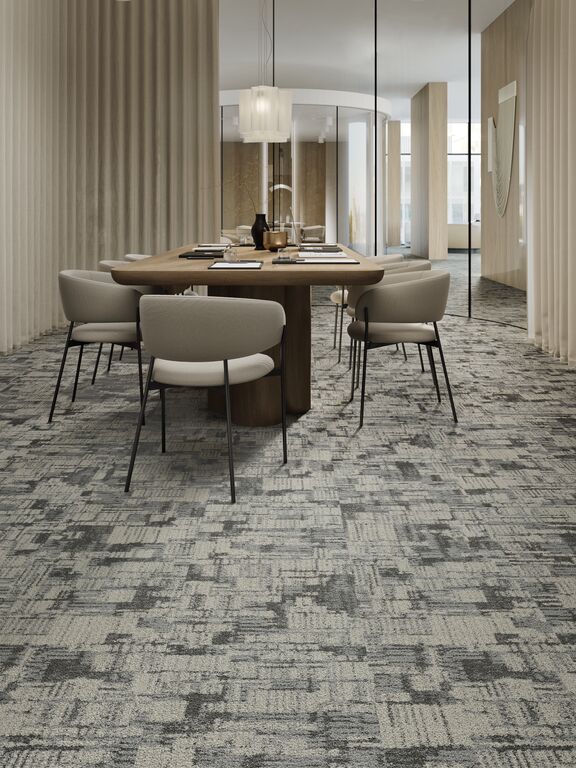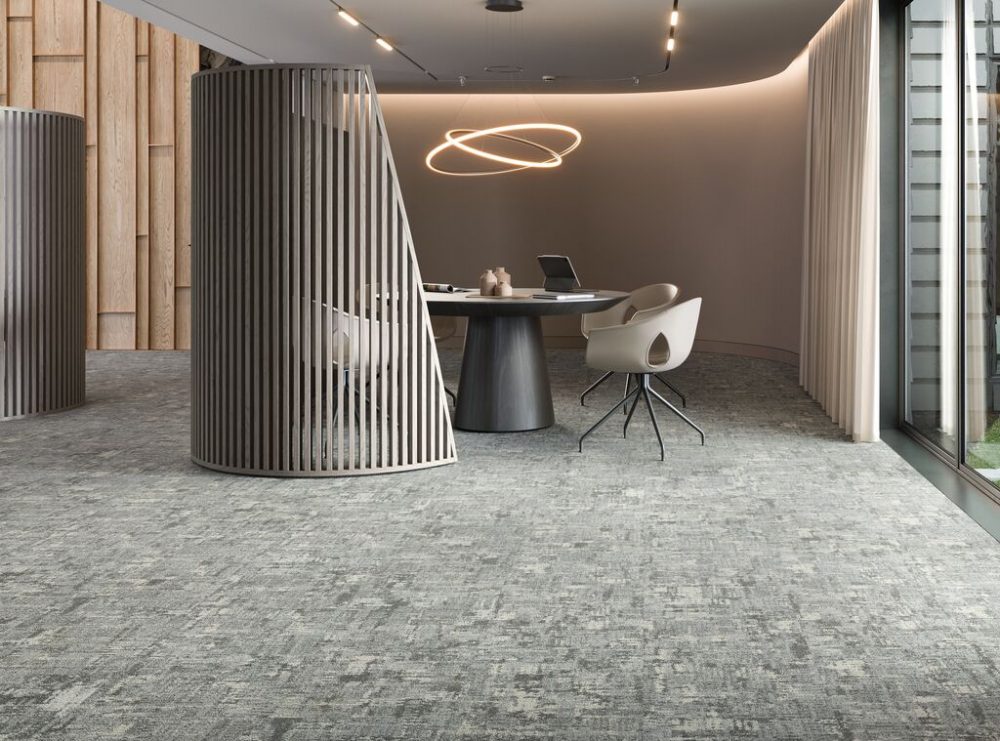In 2026, workplace design intent continues to move toward a deeper connection between people and place: spaces that resonate.
The new workplace is no longer a static environment; it’s a living rhythm of focus, creativity, and connection. Flooring plays a key role in shaping that energy, defining flow, grounding zones, and offering comfort that feels both tactile and emotional.
The Resonant Spaces Collection draws inspiration from this invisible dialogue between people and place. Like a well-composed piece of music, it layers tone, texture, and movement to create interiors that feel attuned to human rhythm, supporting focus when needed and connection when desired. Within this philosophy, four design trends are emerging to define the next era of commercial flooring.

Direction and Shift: Tempo
As offices become more open and agile, flooring takes on the role of quiet navigation. The directional layout trend creates intuitive zones without the need for walls. A shift in tile direction subtly signals transitions between focus and collaboration spaces, while mixed-width layouts introduce visual cadence.
When paired with the Resonant Spaces approach, these rhythmic layouts echo the natural tempo of work life: structured yet dynamic, deliberate yet flowing. It’s about creating an invisible choreography underfoot, where design quietly guides energy through the room.
That quiet sense of motion is embodied in the style Subtle Forces. With its striated tonal shifts and rhythmic geometry, this style captures the mesmerizing energy that defines a space. Installed along circulation paths or key transitions, it creates visual and spatial continuity; an undercurrent of movement that feels intuitive rather than imposed.
Soft Geometric Carpet Tile: Pattern that Listens
Tone-on-tone geometric patterns such as triangles, tessellations, and fractured diamonds are gaining momentum for 2026 in their ability to create visual texture without visual noise. The result is a surface that engages the eye gently, enhancing spatial definition while supporting acoustic comfort.
The Resonant Spaces Collection channels this trend through subtle geometry rendered in layered textures and restrained colorways. The Beneath style captures this aesthetic perfectly. With its layered motif and nuanced negative space, it suggests depth and quiet movement, a visual rhythm that draws you in rather than demanding attention.

Linear and Gradient Flow: Energy in Motion
Movement isn’t only about physical circulation; it’s about energy. Linear flowing patterns and color gradients are gaining momentum for their ability to subtly suggest motion across the floor.
Gradients and directional lines can create dynamic impact in any space, guiding the eye and encouraging movement in a subtle or invigorating way.
Within Resonant Spaces, this concept manifests as gentle directional shifts, with the style Subtle Forces mirroring this trend. Its rhythmic linework channels a pulse of energy that moves through a space: structured yet fluid, directional yet calming. The patterning doesn’t divide; it connects, creating the invisible current that keeps a workplace in rhythm.
Mixing Scale and Texture: The New Dimensionality
Uniformity is giving way to curated variety. In 2026, we’ll see more blending of large and small scales, contrasting textures, and pairing matte with sheen to create more tactile, dimensional floors. The result is a multisensory surface, engaging to the eye, grounding to the mind, and resonant to the experience of space. Look forward to a combination of pattern scales or pile heights that achieve quiet sophistication.

Resonant Spaces embraces this layered tactility through its mix of textures and pile heights, inviting both the eye and the foot to explore subtle contrasts. This layered tactility comes alive in the interplay between Beneath and Intangible. While Beneath introduces depth through subtle negative space, Intangible offers an ethereal counterpoint as a softened, uniform texture. Together, they express a dialogue between depth and stillness, energy and calm.
The Rhythm Within Design
In the evolving workplace, flooring is more than a background element; it’s the emotional baseline of a space. People gravitate toward environments that feel right, those where texture, tone, and movement align with human rhythm. The most compelling workplaces of 2026 are designed with that in mind. They’re not simply places to perform tasks; they’re dynamic environments that shape human energy through light, material, texture, and rhythm.
Resonant Spaces illustrates a distinct yet complementary dimension of resonance: movement, depth, and calm.
Together, the styles translate the invisible rhythms of work life into spaces that energize, balance, and restore.
Incorporating 2026 flooring trends, the Resonant Spaces collection empowers designers to create interiors that don’t just function but feel alive. It’s design that listens, responds, and connects. Because when a space resonates with you, something shifts. Energy flows. Focus deepens. Creativity awakens. Work begins to feel less like an obligation, and more like a rhythm you were meant to move to.
This article was created in partnership with Tarkett.


